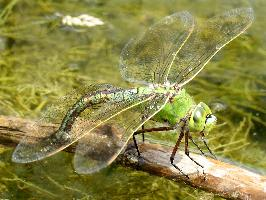
Poids et mesures
| Longueur | 76 mm |
|---|---|
| Envergure des ailes | 80 mm |
Description de l'animal
The Green Darner (Anax junius) is a striking and formidable species of dragonfly that belongs to the Aeshnidae family, known for their large sizes and powerful flight. This species is one of the most widespread and easily recognizable dragonflies across North America, extending its range into Central America and the Caribbean. It is named for its vibrant green thorax and the distinctive "bull's-eye" pattern on its head, which make it an easily identifiable species even for casual observers.Adult Green Darners measure an impressive 3 to 3.5 inches (76 to 89 mm) in length, showcasing a brilliant array of colors. The males exhibit a bright blue abdomen that contrasts sharply with their green thorax, while females and juveniles might present a more muted hue, with reddish or brownish tones complementing the green. Both sexes have clear wings that can span up to 4 inches (about 102 mm) across, allowing them to catch the wind and glide with ease and agility.
The Green Darner is a migratory species, exhibiting one of the most fascinating behaviors in the insect world. Unlike most dragonflies, Green Darners migrate in large groups from the northern United States and Canada to Texas and Mexico for the winter. This journey is made in stages, with multiple generations completing the round trip. The dragonflies that return north in the spring to breed are not the same individuals that flew south the previous fall, showcasing an incredible instinctual drive across generations.
Green Darners are voracious predators, both in their larval and adult stages. As nymphs, they live in freshwater habitats ranging from ponds and lakes to marshes and slow-moving rivers, where they hunt a variety of aquatic invertebrates. They are known for their aggressive hunting technique, using their powerful mandibles to capture prey. Upon reaching adulthood, their diet expands to include an array of flying insects, which they catch on the wing with remarkable precision. Their hunting prowess is facilitated by their excellent vision, provided by two large compound eyes that cover most of their head.
Reproduction is a key aspect of the Green Darner's lifecycle. After mating, the female lays her eggs in aquatic vegetation, inserting them into plant tissue using her specially adapted ovipositor. This ensures that the eggs are placed in a secure location, protected from predators. The eggs hatch into nymphs, which will undergo several molts as they grow, eventually emerging from the water as adults after a process known as metamorphosis.
The Green Darner's role in the ecosystem is multifaceted. As predators, they help control populations of mosquitoes and other insect pests, contributing to human comfort and health. Their presence in diverse aquatic and terrestrial habitats also makes them valuable indicators of environmental health and biodiversity.
In summary, the Green Darner is not just a common sight in the skies above North America; it is a symbol of the intricate connections within ecosystems and the remarkable phenomena of insect migration. Its striking appearance, fascinating life history, and ecological importance make it a species of interest not only to entomologists and nature enthusiasts but to anyone who appreciates the complexity and beauty of the natural world.
Animaux similaires
Nouvelles photos d'animaux
Top 10 des animaux
- Dolphin gull (Leucophaeus scoresbii)
- Diana monkey (Cercopithecus diana)
- Moustached guenon (Cercopithecus cephus)
- Galápagos tortoise (Geochelone nigra complex)
- Stone loach (Barbatula barbatula)
- Japanese macaque (Macaca fuscata)
- Russian tortoise (Testudo horsfieldii)
- Greek tortoise (Testudo graeca)
- Common flying dragon (Draco volans)
- Vendace (Coregonus albula)

